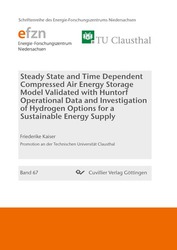| Areas | |
|---|---|
| Serie de libros (96) |
1378
|
| Nachhaltigkeit |
3
|
| Gesundheitswesen |
1
|
| Letra |
2364
|
| Ciencias Naturales |
5406
|
| Ciencias Ingeniería |
1792
|
| Ingeniería | 292 |
| Ingeniería mecánica y de proceso | 862 |
| Ingeniería eléctrica | 686 |
| Mineria y metalurgía | 30 |
| Arquitectura e ingeniería civil | 75 |
| General |
98
|
|
Leitlinien Unfallchirurgie
5. Auflage bestellen |
|
Erweiterte Suche
Steady State and Time Dependent Compressed Air Energy Storage Model Validated with Huntorf Operational Data and Investigation of Hydrogen Options for a Sustainable Energy Supply (Volumen 67) (Tienda española)
Friederike Kaiser (Autor)Previo
Lectura de prueba, PDF (290 KB)
Indice, PDF (29 KB)
Wind power and photovoltaic energy play a significant role in sustainable energy systems. However, these two renewable energy sources do not generate electrical energy on demand and are subject to natural fluctuations. Thus, the need for compensatory measures arises. Compressed air energy storage power plants (CAES) are a possible solution to providing negative and positive control energy in the electric grid. However, in contrast to other energy storage devices such as pumped hydro energy storage or batteries, the storage medium compressed air hardly contains any energy (or more precisely: enthalpy). Yet, compressed air storage allows the operation of highly efficient gas turbines, which are not only particularly fast available but also achieve better efficiency than combined cycle power plants used today, as illustrated by the example of the modern gas and steam power plant Irsching with ηtc = 60%from 2011 compared to the 20 years older McIntosh CAES with ηtc = 82.4 %.
In this thesis, the calculation methods for the thermodynamics of the CAES process are presented and validated by measured data from the operations of the CAES power plant Huntorf. Both the steady state and the dynamic (time-dependent) analyses of the process take place. The characteristic value efficiency is discussed in detail, since numerous different interpretations for CAES exist in the literature. A new calculation method for the electric energy storage efficiency is presented, and a method for the calculation of an economically equivalent electricity storage efficiency is developed. Consideration is given to the transformation of the CAES process into a hydrogen-driven and, thus, greenhouse gas-free process. Finally, a model CAES system is tested in a 100 % renewable model environment.
Consequently, it can be stated that in the steady-state thermodynamic calculation in particular, the consideration of realistic isentropic efficiencies of compressors and turbines is essential to correctly estimate the characteristic values of the process. Furthermore, a steadystate view should always be accompanied by dynamic considerations, since some process characteristics are always time-dependent. The simulation shows that by mapping transient operating conditions, the overall efficiency of the system must be corrected downwards. Nevertheless, in the model environment of a 100 % renewable energy system, it has been shown that a CAES is a useful addition that can provide long-term energy storage.
| ISBN-13 (Impresion) | 9783736973411 |
| ISBN-13 (E-Book) | 9783736963412 |
| Formato | A5 |
| Idioma | Inglés |
| Numero de paginas | 164 |
| Laminacion de la cubierta | mate |
| Edicion | 1 |
| Serie | Schriftenreihe des Energie-Forschungszentrums Niedersachsen (EFZN) |
| Volumen | 67 |
| Lugar de publicacion | Göttingen |
| Lugar de la disertacion | Clausthal-Zellerfeld |
| Fecha de publicacion | 17.12.2020 |
| Clasificacion simple | Tesis doctoral |
| Area |
Ingeniería de energía
|
| Palabras claves | Druckluftspeicherkraftwerk, Wasserstoff, Wasserstoffverbrennung, Silobrennkammer, Energiespeicher, Erneuerbare, Systemdienstleistung, Regelenergie, Gaskraftwerk, Flexibles Kraftwerk, Thermodynamik, Schwarzstartfähig, Power-to-heat, Sektorkopplung, Energiesystem Simulation, Carnot-Wirkungsgrad, Windenergie, Photovoltaik, Wirkungsgrad, Enthalpie, Entropy, Druckluft, Phasenschieber, Huntorf, McIntosh, Salzkaverne, Sole, Reales Gas, Ideales Gas, Engineering equation solver, CAES, Compressed air energy storage, Compressed air storage, Gas power station, Ramp up time, Renewable energy, Renewable energy, Power control, Black start ability, Energy system simulation, Efficiency, Enthalpy, Entropy, Thermodynamics, Hydrogen combustion, Huntorf, McIntosh, Salt cavern, Solution mining, Battery, Carnot, Engineering equation solver, hydrogen, hydrogen combustion, silo combustion chamber, Hochlaufzeit, Leistungssteuerung, Energieeffizienz, Bergbau, Energiequelle, energy source, Stromschwankungen, current fluctuations, Speichermedium, Druckluft, compressed air, Treibhausgase, greenhouse gases, Exergiebilanz, Wärmeübertragungseinheit, thermal transfer unit, thermal transfer unit, energy balance, energy flow, Energiefluss, Turbine, Brennstoff, fuel, combustion, Abgase, exhaust gases, Stromproduktion, energy prices, Energiepreise, Drosselklappe, the throttle, electricity generator, high Pressure Turbine |








